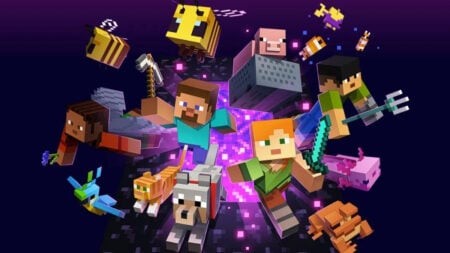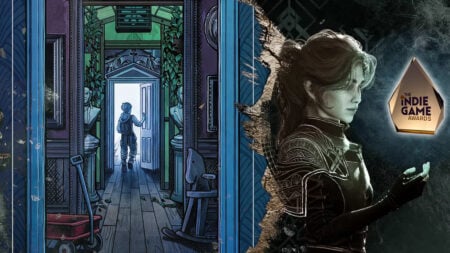Skip To...
Alan Wake 2 turns a witches’ brew of inspiration into a potion of pure enchantment. It borrows from genre giants but never settles for imitation. It invigorates and reinvents. Survival horror and mystery fans will be able to point out a hundred sly references within, yet the story of Alan and Saga never becomes a cheap copycat. Remedy Entertainment tells a funny, gruesome, and heartbreaking detective story that pushes players in new and unexpected ways. There are minor flaws, but they’re mere scratches on the surface of a timeless statue. Somehow, the developer of Control has outdone itself once more.
Alan Wake 2 Review: Another Chapter

Alan Wake 2 is proper metafiction. It’s a killer mystery that winks at the audience without spoiling the suspension of disbelief. The player jumps back and forth between Alan Wake, a famous writer gone missing for over a decade, and Saga Anderson, an FBI agent assigned to unravel the truth behind a bizarre killing in a small town. The game transitions seamlessly between poignant cutscenes and exploration before testing the player with an explosion of tense combat or brain-tickling puzzles. In a difficult genre that relies on atmosphere and pacing more than almost any other, the list of games that outperform Alan Wake 2 is vanishingly small.
Story: Evidence of Wrongdoing

The bones of a good killer mystery change little: someone is dead, and someone else wants to know why. Many of the best moments in Alan Wake 2 come from unraveling that mystery for oneself, so in order to avoid spoiling the experience, it’s best to focus on those doing the unraveling. Saga and her partner Casey have come to Bright Falls to investigate on behalf of the FBI. Unfortunately, it’s exactly the kind of small town you don’t want to visit. On the surface, Bright Falls is comfortable and quiet, with just a handful of eccentric locals doing their best. The truth is more complicated, to say the least.
If you assembled a dream board of your favorite creepy detective stories and then asked a genie to bring it to life, you’d get Alan Wake 2. There are echoes of True Detective, The Killing, and Silent Hill, but the major inspiration is Twin Peaks. Even if you weren’t watching surrealist mystery shows in the ’90s, you’d know its distinct brand of Lynchian weirdness immediately. Everyone has a strangeness to them, as if they have one foot in a dream at any given time. It’s a vibe that’s been attempted countless times. Alan Wake 2 is one of the only games to pull it off while feeling like more than a mere homage.
You alternate between controlling Saga and Alan. There are significant differences in the style of their stories as well as their mechanics, but the overall thrust of the action is the same. You’re here to solve a case. That requires careful exploration, talking to locals, and piecing things together one footprint and blood splatter at a time. As Saga you’ll assemble evidence, tracking its progress by pinning photos to an evidence board and connecting them with string. As Alan, you’ll piece together the story in a more literary way.

Saga is a fascinating character and just as worthy of the stage as Wake himself. In Alan Wake 2, impeccable dialog, mo-cap, and voice acting give characters life. These are arguably some of the best performances in recent history, and that’s as true of Saga as it is of the game’s minor characters. Detectives are often rudely shoehorned into one or two cliches. Saga always feels like she’s more than just her job, and she’s the perfect compliment to her partner, Casey. Their conversations have the spellbinding rhythms of Rust and Marty from True Detective, even when the substance of their chats isn’t so bleak.
Saga may have the best interpersonal storytelling, but Wake has the best environmental storytelling. The Dark Place hasn’t been kind, and his journey is a surrealist nightmare. Wake is no detective, so he instead uses his talents as a writer to reconstruct scenes and claw answers from the tapestry of madness surrounding him. After Alan Wake 2, he may be the definitive portrayal of an overwhelmed artist clinging to their last frayed nerve. Without ruining the story, it’s impossible to explain exactly why Wake’s tale is so obsessively watchable, but it is. Whether he’s using a shotgun and flashlight to fight nightmarish shadows or drowning in a conversation he could never prepare for, Wake is perfection.
Alan Wake 2 has one of the most riveting and unpleasant prologues in recent memory, and the calculated awfulness just gets better with every beat. The emotional highs and lows of the investigation are paced to perfection, so no scene or mechanic outstays its welcome, even if you’re chasing trophies. It’s a story that indulges leisurely exploration if you insist on poking around behind every shrub and in every bathroom stall. Still, if you’re frothing for gunplay, chases, and emotional revelations, you can find those just as easily. Alan Wake 2‘s story is the perfect condensation of David Lynch, Thomas Ligotti, and a dozen other masters of the genre.
Gameplay: Burn Back the Dark

With more than one sprawling mystery to solve, it’s no surprise that exploration and investigation form the backbone of Alan Wake 2. You can swap from the real world to Saga’s Memory Place (or Wake’s Writing Room) with the press of a button, smoothly transitioning from gathering evidence to assembling and examining it. Not having to run back to base or deal with disorganized quest journals to assemble what you’ve learned feels amazing. Embodying the protagonists’ thoughts in these physical spaces is nothing short of brilliant, and it’s something that other games in the genre should immediately steal.
Exploration is consistently rewarding, giving players a good reason to poke and prod in every corner. Whether you’re hunting for evidence, upgrade materials, or healing items and ammunition, the world is littered with things to discover. That’s fortunate because the route to your objective can get complicated, especially when puzzles are involved. Level design is close to flawless, and I rarely had to wander long before discovering which step to take next. Bright Falls, Watery, and the other locations can be overwhelming in their detail, but they do a great job of pointing the way.
Combat, like the story, is prone to spoilers. That said, it’s exceptional. Alan Wake 2 doesn’t do anything revolutionary when it comes to combat mechanics. Instead, it takes tried and true formulas and hones them to their sharpest possible edge. At a basic level, the gunplay isn’t meaningfully different than that of Resident Evil 4. It’s the level of polish that makes it worthwhile. Dodges and impacts feel weighty, guns have a satisfying snap, and enemies are legitimate threats rather than mere bullet sponges. You won’t be in a gunfight every 10 seconds, but combat is always exciting when it arrives.

Whether you’re battling wolves or something more monstrous, a simple pistol won’t cut it forever. A shotgun, crossbow, and more exotic weapons eventually fill your arsenal. You can then upgrade them to add impactful buffs or new effects. Scrounging for necessary upgrade materials is just one good reason to explore because some of the game’s bosses pose a significant challenge. Fans of Resident Evil and similar titles will immediately recognize the simple space-saving puzzle that is inventory management in Alan Wake 2. You have generous storage space at checkpoints, so it never becomes obnoxious.
When Alan and Saga aren’t fighting for their lives, looking for clues, or talking to someone, they’re solving puzzles. As with combat, Alan Wake 2 polishes established mechanics rather than inventing something new. To open a door, you need a keycard, but the power is off, so first, you’ll need to find a fuse and restore power to the generator. Even if you aren’t compelled by nostalgia to find this kind of puzzle endearing, they’re well done and largely enjoyable. Some games in the genre are famous for their obtuse puzzles and riddles, but puzzles in Alan Wake 2 all feel fair and provide sufficient in-game instructions.
Despite having Alan’s name in the title, this is very much a two-protagonist game. Upon reaching a certain point in the story, you can swap between Saga and Alan at designated save points. Though elements of their stories run parallel, the vast majority of content is unique to each character. That, combined with the ability to take on their stories in whichever order you choose, allows you to shift styles of content as you see fit. One can only imagine the nightmare of trying to balance this system in a fun and satisfying way. Whatever pain the developer went through was worth it because the results are outstanding.
Graphics & Audio: Bumps in the Night

Rain drips and patterns between wind-tossed boughs. The light filtering over the mountains and into the forest is pastry-soft and just as fragile. All the ingredients for a soothing meditation tape are here, but this forest is anything but relaxing. Saga’s sneakers squeak with every step. Her fingers flex on her pistol as the beam of her flashlight darts through the trees. Someone or something is whispering, and it wouldn’t be so bad if she didn’t know what it was saying. Alan Wake 2 is a masterclass in audio-visual design.
From the throaty rumbles of the title music to the distilled white noise of the sheriff’s office, Alan Wake 2 is an audiophile’s delight. Gunshots and ambient noise feel equally natural and full. The morning hum of a coffee shop couldn’t feel any more Twin Peaks if it tried. The voice acting deserves a special shoutout. One expects the game’s stars to be extraordinary. Yet the talent behind even minor NPCs in Alan Wake 2 is just as impressive. It’s a cast of charming and believable weirdos. The itch to see what they do or say next is real.

Alan Wake 2 is the rare title that uses ray tracing to its fullest, lighting scenes in ways that would otherwise be impossible. On lower settings, it still looks great. Yet, if you want to see this game in all its grandeur, you’ll need some impressive hardware. Countless thrillers and survival horror games take place in creepy forests. Few understand what being in such forests is actually like. There’s a certain way that boughs bend in the wind as a storm approaches, a certain way that the leaves dilute twilight and leave it hanging like fishnet across the ground. Few games have the budget, talent, or ambition to capture this, but Alan Wake 2 does.
The game doesn’t just excel at realism, despite its brilliant use of live-action performances. The audio-visual design of supernatural and surreal moments is just as good. You can see it in the way certain enemies crackle and twitch when you point a flashlight at them. A few set-piece moments are visual extravaganzas. If they weren’t major spoilers, it would be worth spending an entire review dissecting them. The game can be overwhelming in all the best ways. It’s the kind of game where you’d rather walk than run because there’s just that much to see.
Conclusion: A Bright Place

Alan Wake 2 has flaws, but they’re few and far between. I experienced only a couple of bugs and a few immersion-breaking moments resulting from questionable writing. It’s a remarkably polished game that clearly received love and attention at every step of the design process. It’s probably the only game in Remedy Entertainment’s catalog to compete with Control and Max Payne 2 regarding the deep storytelling, enjoyable mechanics, and visual audacity. Whether it’s the frontrunner or dark horse, Alan Wake 2 demands a place in Game of the Year conversations going forward.
The review was done on PC with a code provided by the publisher.
Alan Wake 2 is available for PC, PlayStation 5, and Xbox Series X/S. Here is a video of the game running on our test machine with a i9 9900k, Nvidia 4070 12gb, and an NVME Drive.
Alan Wake 2 (PC Reviewed)
A gripping psychological horror story that nails the supernatural as well as the mundane.
Pros
- Stunning visuals
- Clever reality-shifting gameplay
- Excellent story
Cons
- Rare immersion breaking moments
- Occasionally frustrating puzzles








